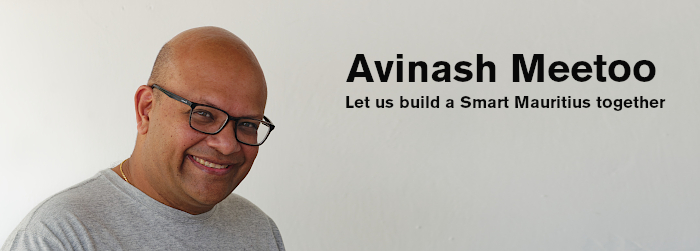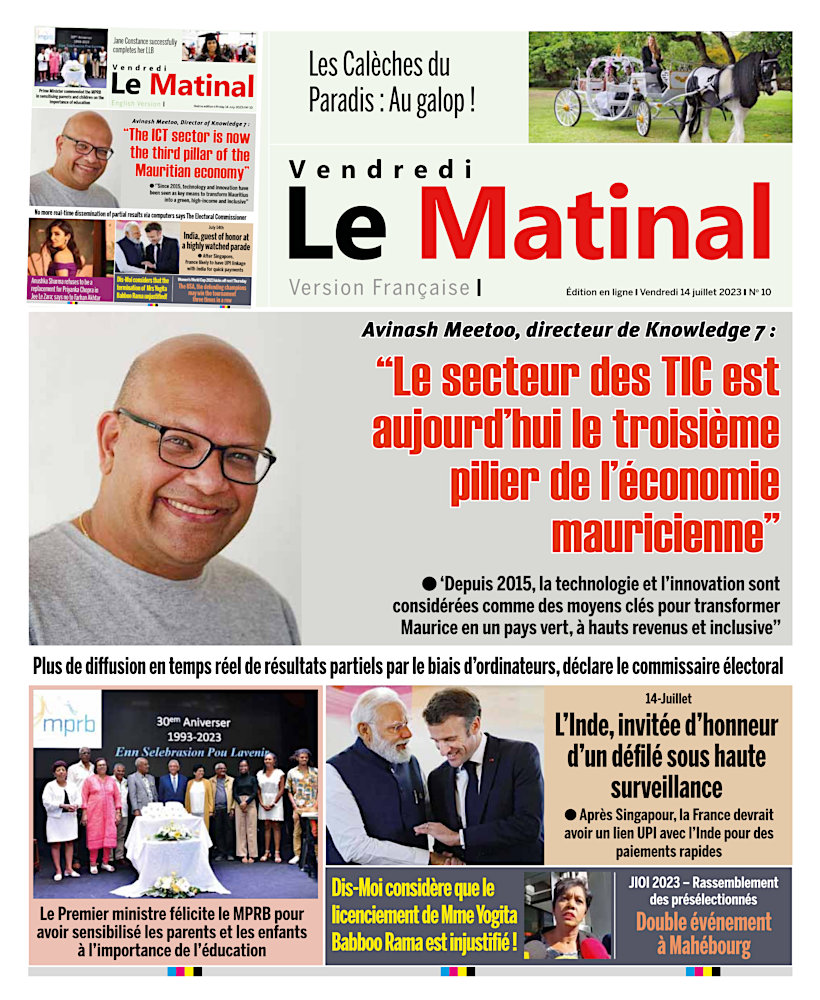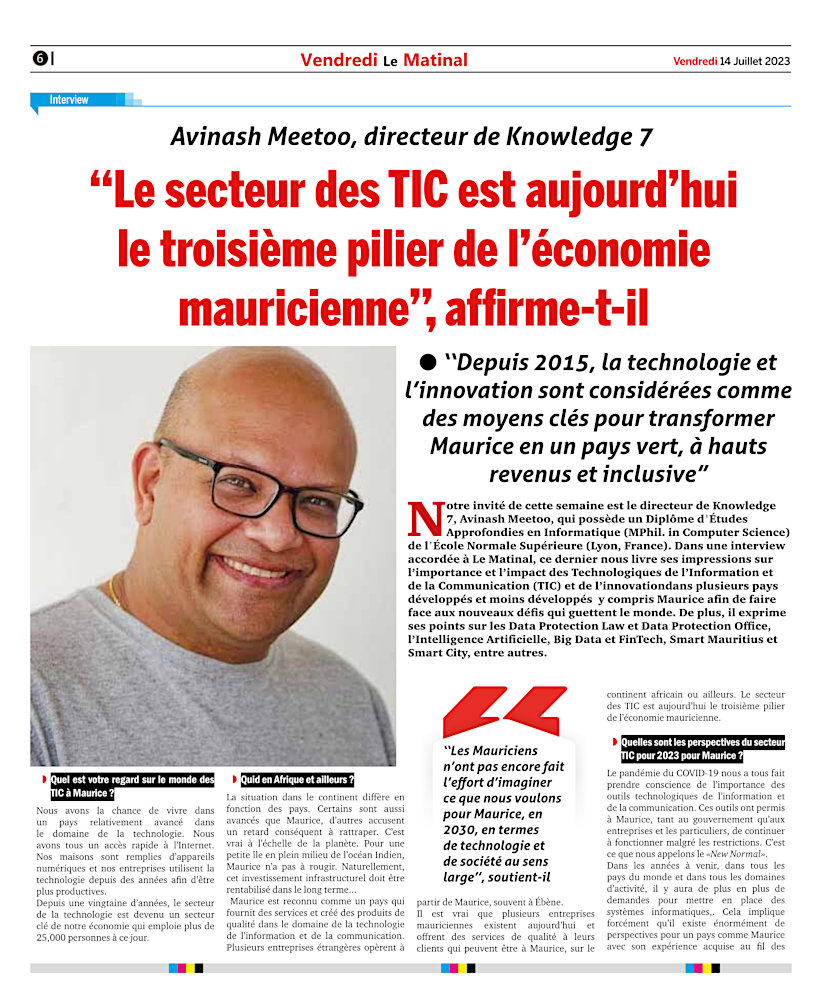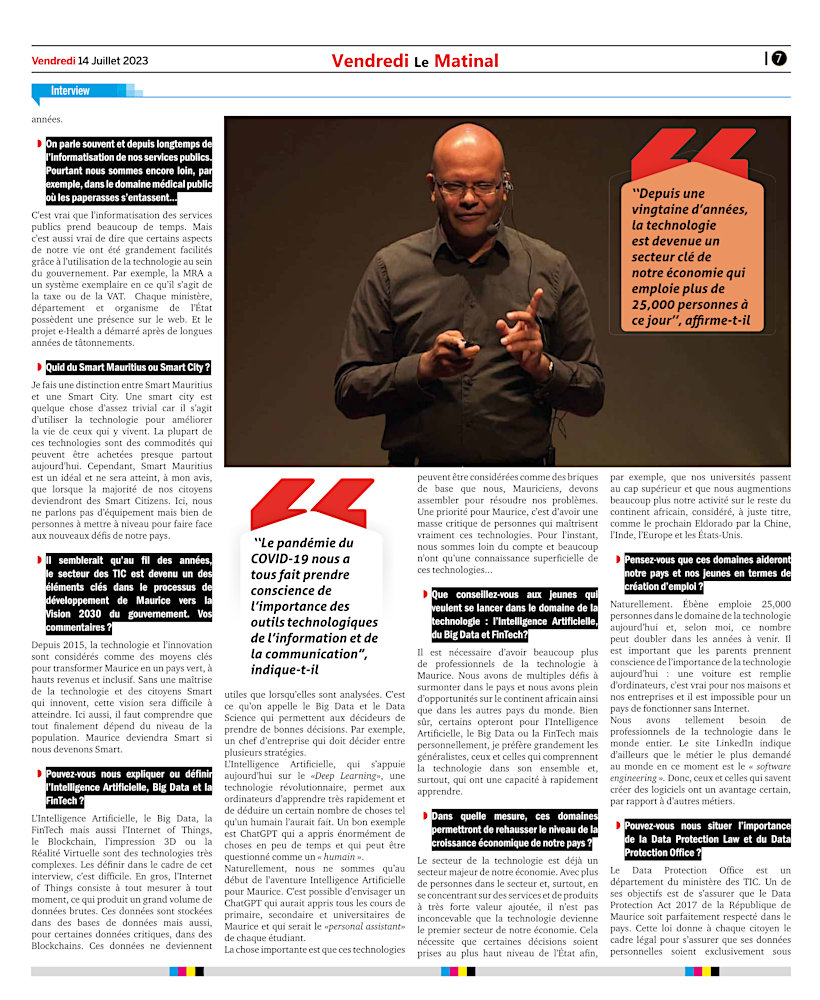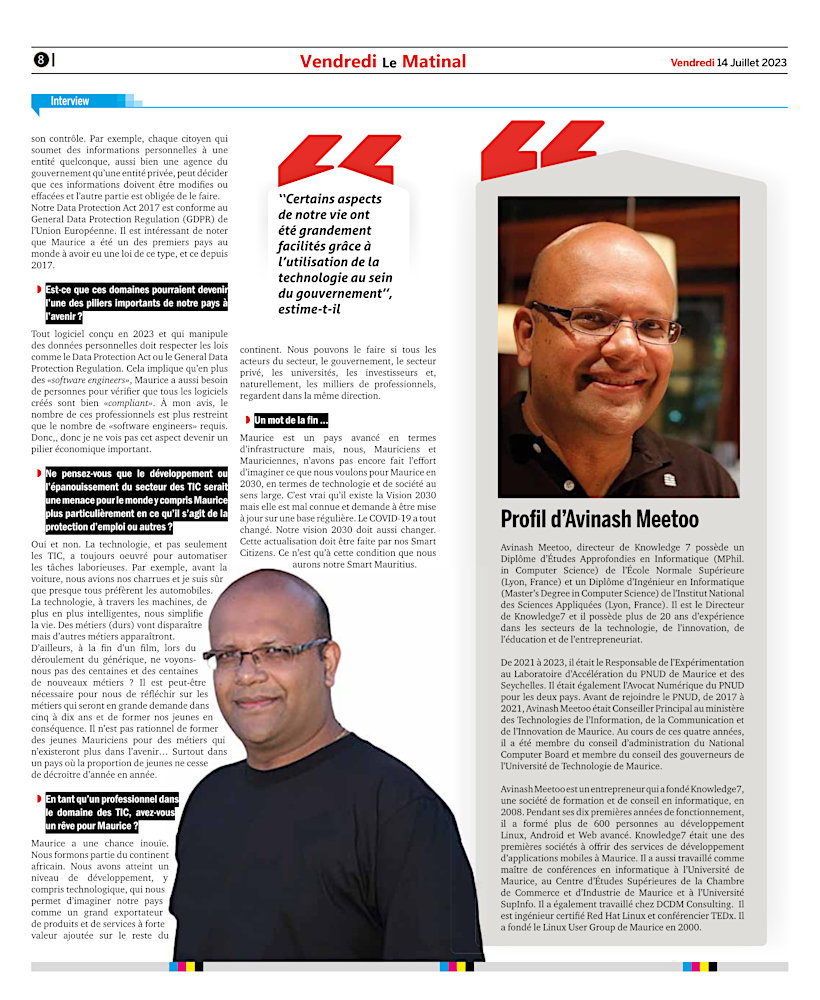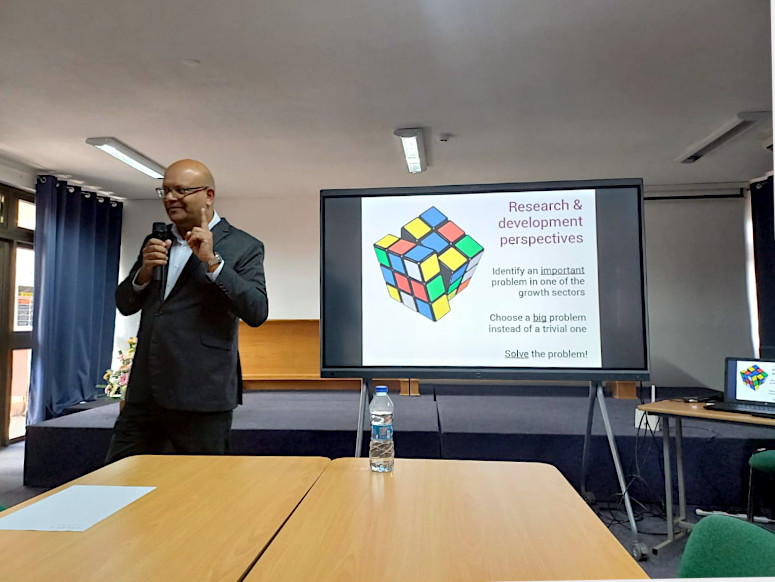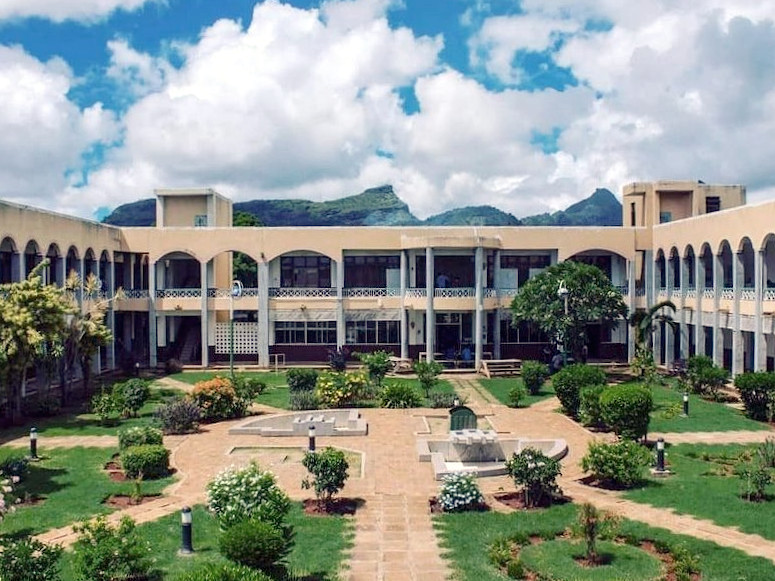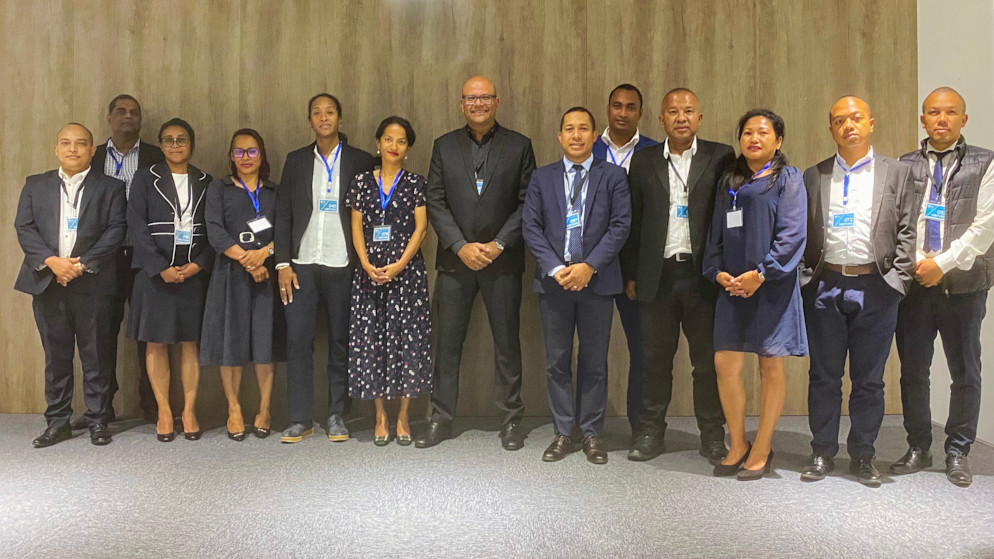Le vendredi 14 juillet 2023, j’ai donné un entretien dans l’édition numérique du Matinal, aussi bien en français qu’en anglais sur l’évolution de la technologie à Maurice et son impact sur notre futur. Cet entretien a été effectué par M. Sanjay Bijloll.
Quel est votre regard sur le monde des TIC à Maurice ?
Nous avons la chance de vivre dans un pays relativement avancé dans le domaine de la technologie. Nous avons tous un accès rapide à l’Internet. Nos maisons sont remplies d’appareils numériques et nos entreprises utilisent la technologie depuis des années afin d’être plus productives.
Depuis une vingtaine d’années, le secteur de la technologie est devenu un secteur clé de notre économie qui emploie plus de 25,000 personnes à ce jour.
Quid en Afrique et ailleurs ?
La situation dans le continent diffère en fonction des pays. Certains sont aussi avancés que Maurice, d’autres accusent un retard conséquent à rattraper. C’est vrai à l’échelle de la planète. Pour une petite île en plein milieu de l’océan Indien, Maurice n’a pas à rougir. Naturellement, cet investissement infrastructurel doit être rentabilisé dans le long terme…
Maurice est reconnu comme un pays qui fournit des services et créé des produits de qualité dans le domaine de la technologie de l’information et de la communication. Plusieurs entreprises étrangères opèrent à partir de Maurice, souvent à Ébène.
Il est vrai que plusieurs entreprises mauriciennes existent aujourd’hui et offrent des services de qualité à leurs clients qui peuvent être à Maurice, sur le continent africain ou ailleurs. Le secteur des TIC est aujourd’hui le troisième pilier de l’économie mauricienne.
Quelles sont les perspectives du secteur TIC pour 2023 pour Maurice ?
Le pandémie du COVID-19 nous a tous fait prendre conscience de l’importance des outils technologiques de l’information et de la communication. Ces outils ont permis à Maurice, tant au gouvernement qu’aux entreprises et les particuliers, de continuer à fonctionner malgré les restrictions. C’est ce que nous appelons le « New Normal ». Dans les années à venir, dans tous les pays du monde et dans tous les domaines d’activité, il y aura de plus en plus de demandes pour mettre en place des systèmes informatiques. Cela implique forcément qu’il existe énormément de perspectives pour un pays comme Maurice avec son expérience acquise au fil des années.
On parle souvent et depuis longtemps de l’informatisation de nos services publics. Pourtant nous sommes encore loin, par exemple, dans le domaine médical public où les paperasses s’entassent…
C’est vrai que l’informatisation des services publics prend beaucoup de temps. Mais c’est aussi vrai de dire que certains aspects de notre vie ont été grandement facilités grâce à l’utilisation de la technologie au sein du gouvernement. Par exemple, la MRA a un système exemplaire en ce qu’il s’agit de la taxe ou de la VAT. Chaque ministère, département et organisme de l’État possèdent une présence sur le web. Et le projet e-Health a démarré après de longues années de tâtonnements.
Quid du Smart Mauritius ou Smart City ?
Je fais une distinction entre Smart Mauritius et une Smart City. Une smart city est quelque chose d’assez trivial car il s’agit d’utiliser la technologie pour améliorer la vie de ceux qui y vivent. La plupart de ces technologies sont des commodités qui peuvent être achetées presque partout aujourd’hui. Cependant, Smart Mauritius est un idéal et ne sera atteint, à mon avis, que lorsque la majorité de nos citoyens deviendront des Smart Citizens. Ici, nous ne parlons pas d’équipement mais bien de personnes à mettre à niveau pour faire face aux nouveaux défis de notre pays.
Il semblerait qu’au fil des années, le secteur des TIC est devenu un des éléments clés dans le processus de développement de Maurice vers la Vision 2030 du gouvernement. Vos commentaires ?
Depuis 2015, la technologie et l’innovation sont considérés comme des moyens clés pour transformer Maurice en un pays vert, à hauts revenus et inclusif. Sans une maîtrise de la technologie et des citoyens Smart qui innovent, cette vision sera difficile à atteindre. Ici aussi, il faut comprendre que tout finalement dépend du niveau de la population. Maurice deviendra Smart si nous devenons Smart.
Pouvez-vous nous expliquer ou définir l’Intelligence Artificielle, Big Data et la FinTech ?
L’Intelligence Artificielle, le Big Data, la FinTech mais aussi l’Internet of Things, le Blockchain, l’impression 3D ou la Réalité Virtuelle sont des technologies très complexes. Les définir dans le cadre de cet interview, c’est difficile. En gros, l’Internet of Things consiste à tout mesurer à tout moment, ce qui produit un grand volume de données brutes. Ces données sont stockées dans des bases de données mais aussi, pour certaines données critiques, dans des Blockchains. Ces données ne deviennent utiles que lorsqu’elles sont analysées. C’est ce qu’on appelle le Big Data et le Data Science qui permettent aux décideurs de prendre de bonnes décisions. Par exemple, un chef d’entreprise qui doit décider entre plusieurs stratégies.
L’Intelligence Artificielle, qui s’appuie aujourd’hui sur le «Deep Learning», une technologie révolutionnaire, permet aux ordinateurs d’apprendre très rapidement et de déduire un certain nombre de choses tel qu’un humain l’aurait fait. Un bon exemple est ChatGPT qui a appris énormément de choses en peu de temps et qui peut être questionné comme un « humain ». Naturellement, nous ne sommes qu’au début de l’aventure Intelligence Artificielle pour Maurice. C’est possible d’envisager un ChatGPT qui aurait appris tous les cours de primaire, secondaire et universitaires de Maurice et qui serait le «personal assistant» de chaque étudiant.
La chose importante est que ces technologies peuvent être considérées comme des briques de base que nous, Mauriciens, devons assembler pour résoudre nos problèmes. Une priorité pour Maurice, c’est d’avoir une masse critique de personnes qui maîtrisent vraiment ces technologies. Pour l’instant, nous sommes loin du compte et beaucoup n’ont qu’une connaissance superficielle de ces technologies…
Que conseillez-vous aux jeunes qui veulent se lancer dans le domaine de la technologie : l’Intelligence Artificielle, du Big Data et FinTech?
Il est nécessaire d’avoir beaucoup plus de professionnels de la technologie à Maurice. Nous avons de multiples défis à surmonter dans le pays et nous avons plein d’opportunités sur le continent africain ainsi que dans les autres pays du monde. Bien sûr, certains opteront pour l’Intelligence Artificielle, le Big Data ou la FinTech mais personnellement, je préfère grandement les généralistes, ceux et celles qui comprennent la technologie dans son ensemble et, surtout, qui ont une capacité à rapidement apprendre.
Dans quelle mesure, ces domaines permettront de rehausser le niveau de la croissance économique de notre pays ?
Le secteur de la technologie est déjà un secteur majeur de notre économie. Avec plus de personnes dans le secteur et, surtout, en se concentrant sur des services et de produits à très forte valeur ajoutée, il n’est pas inconcevable que la technologie devienne le premier secteur de notre économie. Cela nécessite que certaines décisions soient prises au plus haut niveau de l’État afin, par exemple, que nos universités passent au cap supérieur et que nous augmentions beaucoup plus notre activité sur le reste du continent africain, considéré, à juste titre, comme le prochain Eldorado par la Chine, l’Inde, l’Europe et les États-Unis.
Pensez-vous que ces domaines aideront notre pays et nos jeunes en termes de création d’emploi ?
Naturellement. Ébène emploie 25,000 personnes dans le domaine de la technologie aujourd’hui et, selon moi, ce nombre peut doubler dans les années à venir. Il est important que les parents prennent conscience de l’importance de la technologie aujourd’hui : une voiture est remplie d’ordinateurs, c’est vrai pour nos maisons et nos entreprises et il est impossible pour un pays de fonctionner sans Internet.
Nous avons tellement besoin de professionnels de la technologie dans le monde entier. Le site LinkedIn indique d’ailleurs que le métier le plus demandé au monde en ce moment est le « software engineering ». Donc, ceux et celles qui savent créer des logiciels ont un avantage certain, par rapport à d’autres métiers.
Pouvez-vous nous situer l’importance de la Data Protection Law et du Data Protection Office ?
Le Data Protection Office est un département du ministère des TIC. Un de ses objectifs est de s’assurer que le Data Protection Act 2017 de la République de Maurice soit parfaitement respecté dans le pays. Cette loi donne à chaque citoyen le cadre légal pour s’assurer que ses données personnelles soient exclusivement sous son contrôle. Par exemple, chaque citoyen qui soumet des informations personnelles à une entité quelconque, aussi bien une agence du gouvernement qu’une entité privée, peut décider que ces informations doivent être modifies ou effacées et l’autre partie est obligée de le faire. Notre Data Protection Act 2017 est conforme au General Data Protection Regulation (GDPR) de l’Union Européenne. Il est intéressant de noter que Maurice a été un des premiers pays au monde à avoir eu une loi de ce type, et ce depuis 2017.
Est-ce que ces domaines pourraient devenir l’une des piliers importants de notre pays à l’avenir ?
Tout logiciel conçu en 2023 et qui manipule des données personnelles doit respecter les lois comme le Data Protection Act ou le General Data Protection Regulation. Cela implique qu’en plus des «software engineers», Maurice a aussi besoin de personnes pour vérifier que tous les logiciels créés sont bien «compliant». À mon avis, le nombre de ces professionnels est plus restreint que le nombre de «software engineers» requis. Donc,, donc je ne vois pas cet aspect devenir un pilier économique important.
Ne pensez-vous que le développement ou l’épanouissement du secteur des TIC serait une menace pour le monde y compris Maurice plus particulièrement en ce qu’il s’agit de la protection d’emploi ou autres ?
Oui et non. La technologie, et pas seulement les TIC, a toujours oeuvré pour automatiser les tâches laborieuses. Par exemple, avant la voiture, nous avions nos charrues et je suis sûr que presque tous préfèrent les automobiles. La technologie, à travers les machines, de plus en plus intelligentes, nous simplifie la vie. Des métiers (durs) vont disparaître mais d’autres métiers apparaîtront.
D’ailleurs, à la fin d’un film, lors du déroulement du générique, ne voyons-nous pas des centaines et des centaines de nouveaux métiers ? Il est peut-être nécessaire pour nous de réfléchir sur les métiers qui seront en grande demande dans cinq à dix ans et de former nos jeunes en conséquence. Il n’est pas rationnel de former des jeunes Mauriciens pour des métiers qui n’existeront plus dans l’avenir… Surtout dans un pays où la proportion de jeunes ne cesse de décroitre d’année en année.
En tant qu’un professionnel dans le domaine des TIC, avez-vous un rêve pour Maurice ?
Maurice a une chance inouïe. Nous formons partie du continent africain. Nous avons atteint un niveau de développement, y compris technologique, qui nous permet d’imaginer notre pays comme un grand exportateur de produits et de services à forte valeur ajoutée sur le reste du continent. Nous pouvons le faire si tous les acteurs du secteur, le gouvernement, le secteur privé, les universités, les investisseurs et, naturellement, les milliers de professionnels, regardent dans la même direction.
Un mot de la fin…
Maurice est un pays avancé en termes d’infrastructure mais, nous, Mauriciens et Mauriciennes, n’avons pas encore fait l’effort d’imaginer ce que nous voulons pour Maurice en 2030, en termes de technologie et de société au sens large. C’est vrai qu’il existe la Vision 2030 mais elle est mal connue et demande à être mise à jour sur une base régulière. Le COVID-19 a tout changé. Notre vision 2030 doit aussi changer. Cette actualisation doit être faite par nos Smart Citizens. Ce n’est qu’à cette condition que nous aurons notre Smart Mauritius.
